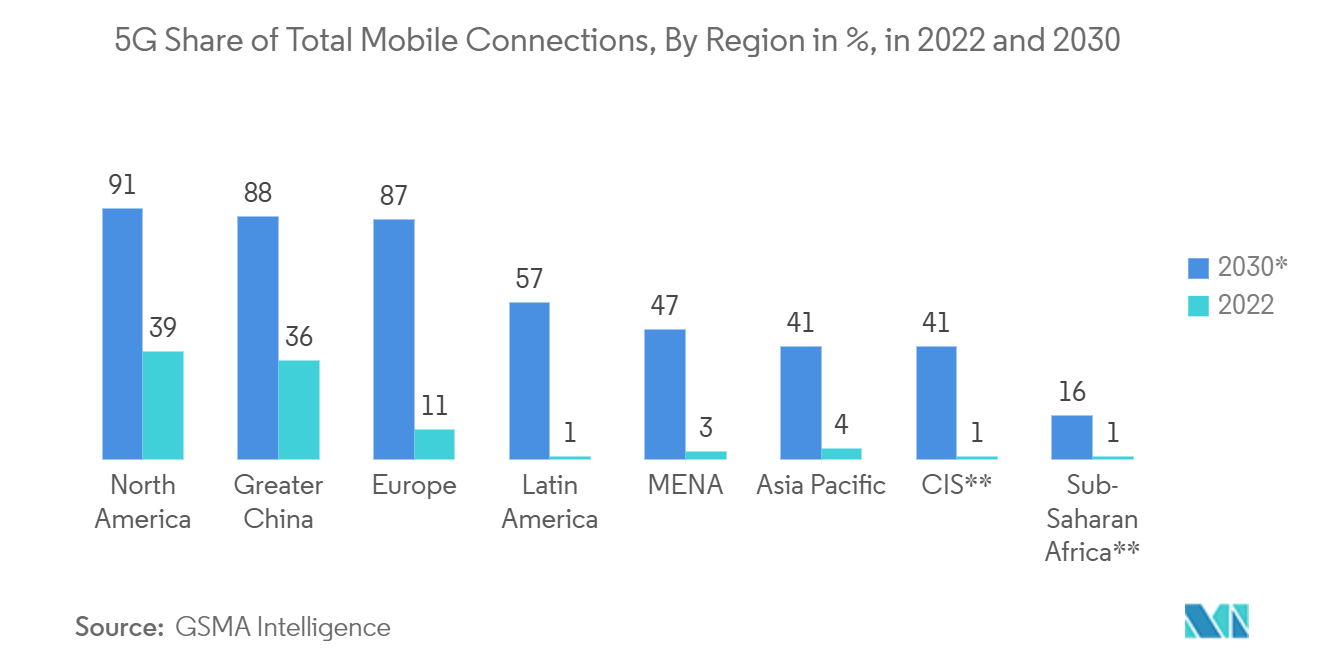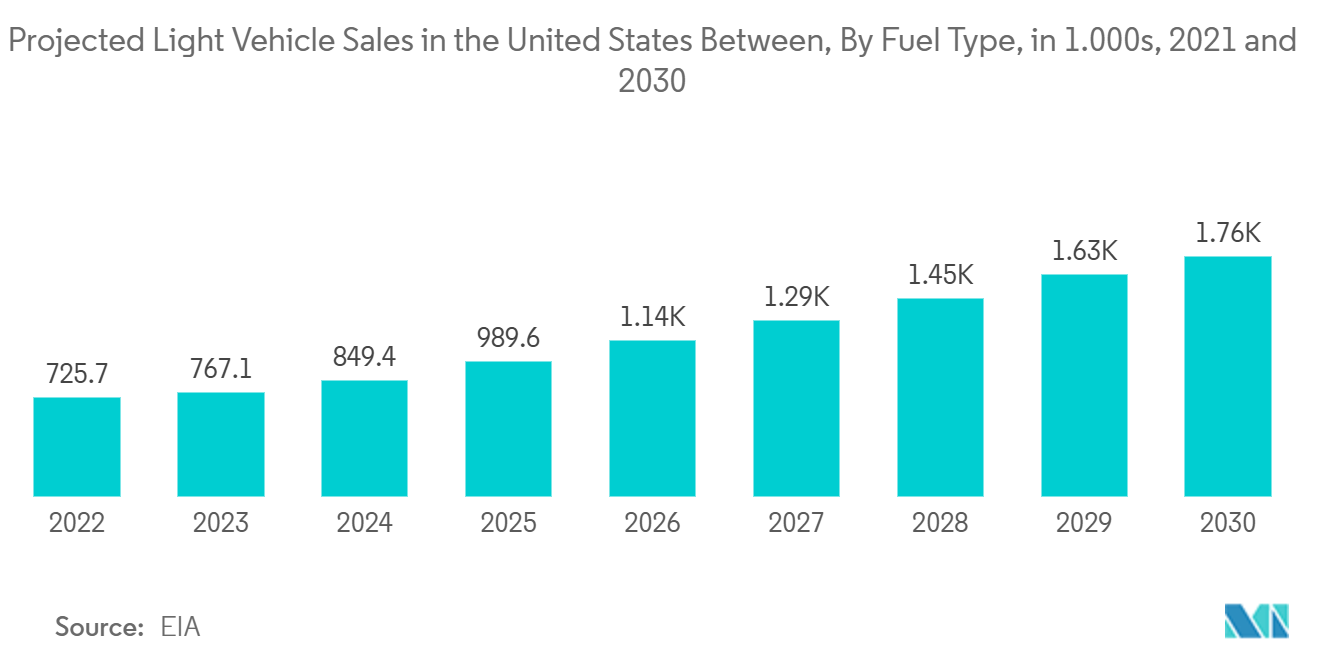Market Trends of Advanced IC Substrates Industry
Mobile Devices and Consumer Electronics Are Expected to Hold Major Market Shares
- The need for mobile communication devices and consumer electronics is compelling mobile and consumer electronics manufacturers to develop smaller and more portable products. The rising inclination toward miniaturization is the main driver behind the demand for advanced packaging. The expanding capabilities of mobile devices and consumer electronics, along with the surging popularity of smart devices and smart wearables, are expected to significantly contribute to the adoption of advanced IC substrates in the projected timeframe.
- The selection of the package for an integrated circuit (IC) is influenced by various factors such as power dissipation, size, price, and other considerations. With the increasing demand for 5G-enabled smartphones and smart wearables worldwide in the coming years, the requirement for advanced IC substrates is expected to increase. Additionally, the growing adoption of state-of-the-art technologies like AI and HPC, along with high-performance mobile devices, including 5G, is fueling the demand for sophisticated IC substrates.
- The global demand for smartphones is projected to witness growth as a result of factors such as the increasing usage of the Internet, the intense promotional campaigns by smartphone manufacturers, and the rising number of subscriptions to social media platforms. Smartphones hold a substantial market share, and the introduction of 5G smartphones is expected to further drive the demand. Renowned global companies like Samsung are investing significantly in the semiconductor industry to establish themselves as prominent vendors in the 5G smartphone market.
- Ericsson reported that the global count of smartphone mobile network subscriptions reached nearly 6.4 billion in 2022; the figure is expected to surpass 7.7 billion by 2028. Notably, China, India, and the United States have the highest number of smartphone mobile network subscriptions. The widespread adoption of 5G technology continues to accelerate, with 1.6 billion connections already established worldwide. According to GSMA Intelligence, this figure is expected to rise to 5.5 billion by 2030. These factors are likely to lead to increased product demand.
- The surge in demand for 5G-capable devices like smartphones is fueling the growth of 5G penetration. According to GSMA, one-third of the global population is expected to have access to 5G networks by 2025. These escalating numbers of communication devices and mobile subscriptions would consequently boost the demand for IC substrates. The proliferation of IoT applications in a wide range of consumer devices led to a rise in smart devices and compact semiconductors, thereby boosting the need for sophisticated IC substrates.
- Numerous companies are producing energy-efficient integrated circuits (ICs), particularly for the consumer electronics industry. Graphics processing units (GPUs), PCs, gaming laptops, and various portable devices have evolved to become viable solutions for a range of emerging applications such as high-performance computing, blockchain, and AI/ML. The increasing need for neural processing units (NPU) to offload tasks from CPUs and other system-on-chip (SoC) components, particularly during AI data processing, is projected to drive up the market demand.
- Increasing investments by the manufacturers of consumer electronics are further expected to increase the potential of the market. In January 2023, LG Innotek organized an event at its newly established Gumi facility, where it was expected to produce FC-BGA. The manufacturing of the flip-chip ball grid array (FC-BGA) is scheduled to commence in February 2023. Following this initial phase, the second phase will commence in 2026. LG Innotek aimed to enhance its FC-BGA production capacity to 7.3 million units per month in 2023; it expects to further increase it to 15 million units per month in 2026.

The United States is Expected to Witness Significant Growth
- The United States is poised for significant expansion in the market over the coming years, necessitating a greater focus on research and development and enhancing independent innovation to build a comprehensive semiconductor industry chain system. The advancement in the region's semiconductor industry, coupled with the enactment of the CHIPS Act to enhance domestic production, led to a surge in demand for advanced IC substrates. The increasing need for these substrates in industries such as automotive and mobile is anticipated to propel the market forward.
- The expansion is driven by the rise in connected and consumer electronics, along with companies' focus on improving quality and offering comprehensive testing solutions. The demand for high-performance, affordable, versatile, and highly integrated chips is expected to grow alongside the increasing sales of consumer electronics, requiring advanced assembly and packaging solutions. As per CTA, smartwatch sales reached USD 7.1 billion in 2022, marking an 8% increase compared to 2021. Moreover, the consumer electronics market experienced growth due to the expansion of 5G, with 5G devices estimated to make up 73% of smartphone shipments in 2023.
- Increasing investments and EV sales in the region's automotive industry are expected to influence the market's growth. The EV market in the United States is thriving, with impressive sales figures. According to COX Enterprise, the sales of battery electric vehicles in the country reached a remarkable 258,900 units in the first quarter of 2023. This represented a substantial year-over-year growth of around 44.9% compared to the figures from the same period in 2022. The first quarter of 2023 surpassed the fourth quarter of 2022, making it the most successful quarter for BEV sales in the country over the previous two years.
- The market's growth is expected to be driven by the increasing efforts to promote the adoption of EVs. According to the IEA, California enforced new ZEV mandates for cars and trucks in 2022 and 2023. These mandates established a minimum sales requirement for ZEVs in the passenger LDV category, with the goal ranging from 35% in 2026 to 100% in 2035. Furthermore, milestones have been set for the sale of zero-emission heavy-duty vehicles (HDVs), with the aim of achieving 100% adoption between 2035 and 2042, depending on the specific vehicle segment. These factors contribute to the rise in EV adoption and will generate more demand for IC substrates.
- The region's chip production capabilities will be enhanced as a result of the growing government efforts to promote semiconductor R&D activities. This, in turn, will drive the market demand. In February 2024, the US government made a noteworthy announcement regarding the dedication to semiconductor-related research and development. It disclosed its intention to allocate a significant sum of USD 11 billion toward this endeavor. It also introduced the National Semiconductor Technology Center (NSTC), an innovative initiative backed by a budget of USD 5 billion. These strategic investments in the semiconductor industry will contribute to the overall expansion of the market in the region.
- The increasing adoption of 5G technology and growing investments in the communications industry are further expected to boost the market's growth. The profits of IC substrate manufacturers are boosted by the advancements in IoT. Apple planned to incorporate mmWave antenna into its 5G iPhones and 5G iPads by utilizing TSMC's antenna in package technology and ASE's FC AiP process. The expansion of IoT led to increased utilization of the latest semiconductor packages, which can improve the performance of ICs and reduce costs in various applications.


